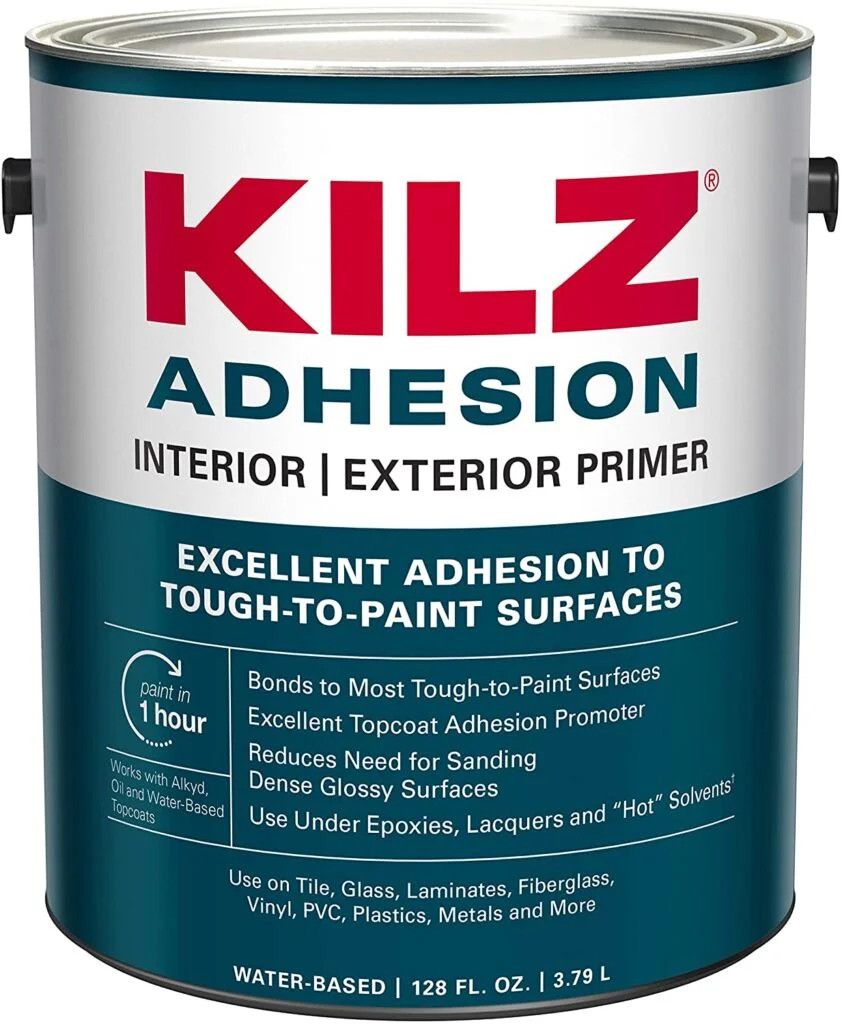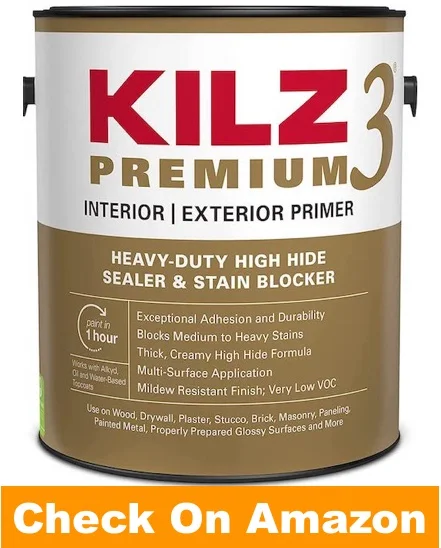
A good quality primer can make an imperfect wall look perfect. Kilz is one of the best paint brands when it comes to affordability. Kilz 2 and Kilz 3 are two of their best primers. What are the main differences between Kilz 2 vs Kilz 3?
The main difference between the Kilz 2 and Kilz 3 is thickness. Kilz 3 is a thicker product, which enables the primer to hide dark colors and severe stains more efficiently. However, Kilz 2 is more convenient to apply on walls for its lightness.
Plus, several other distinguishable factors between these water-based primers make them suitable for different usage. Let’s learn more about these Kilz primers and help you decide which one is suitable for your upcoming projects.
Kilz 2 vs Kilz 3: Quick Comparison Chart
Specifications:
| Features | Kilz 2 | Kilz 3 |
| Base | Water | Water |
| Interior/Exterior | Both | Both |
| Color | White | White |
Coverage:
| Features | Kilz 2 | Kilz 3 |
| Coverage (low) | 300 square feet | 300 square feet |
| Mils wet | 5.3 | 5.3 |
| Mils dry | 1.7 | 2.2 |
| Coverage (high) | 400 square feet | 400 square feet |
| Mils wet | 4 | 4 |
| Mils dry | 1.3 | 1.6 |
Application:
| Features | Kilz 2 | Kilz 3 |
| Application temperature | 50°-90°F | 50°-90°F |
| Viscosity | 95-105KU | 95-105KU |
| Dry to touch | 30 minutes | 30 minutes |
| Dry to recoat | 1 hour | 1 hour |
Components:
| Features | Kilz 2 | Kilz 3 |
| Max Tint | 2 oz | 2 oz |
| VOC | <50 g/L | <5 g/L |
| Volume solids | 34.00% | 54.7% |
| Weight solids | 48.50% | 40.50% |
KILZ 2 vs KILZ 3: Key Differences
As you can see in the above charts, there is not much difference between Kilz 2 and Kilz 3. That’s why confusion arises about which KILZ primer to use.
Kilz 2 and Kilz 3 have only a few differences, which are:
1. The thickness of the primers
The thickness of primers is essential to know as they highly influence the appearance of paint. Higher thickness offers a better look but is also expensive.
Kilz 3 is thicker than Kilz 2 for both low coverage and high coverage. Kilz 3’s low coverage Mils dry is 2.2 against Kilz 2’s 1.7, and high coverage Mils dry for Kilz 3 is 1.6 against Kilz 2’s 1.6.
Due to its higher thickness, Kilz 3 can hide scratches, marks, and other imperfections on walls better. Your walls will look completely new after applying Kilz 3 primer.
2. Health effects
VOC or Volatile Organic Compounds in paints are chemicals that act as a medium for transferring the paints from the can to the surface. They are necessary for water-based paints but are unhealthy.
VOC below 250 grams/Liter is considered tolerable. The good thing is VOC in both Kilz primers is quite low. It’s less than 50 g/L in Kilz 2 and less than 5 g/L in Kilz 3.
Keep in mind that these compounds vanish in the air as the primer dries. Kilz 3 is a better choice if you are concerned about your health. You also can go for Kilz 2 as 50 g/L is not too much. Remember to wear masks while painting to avoid the harmful effects.
3. Efficiency
You can measure the efficiency of primers by measuring the percentage of solid properties that are left after the paint dries. Volume solid indicates that percentage.
The volume solid for Kilz 3 is 54.7%, while the volume solid for Kilz 2 is 34%. Anything above 30% is considered okay. In that sense, both of these primers are good.
But if you want a more efficient KILZ water-based primer, Kilz 3 is the better choice. Similar to thickness, a higher volume solid means a higher price.
4. Ease of Use
If you are planning for DIY, then ease of use is an essential deciding factor. I have reached multiple DIY painters to know what their experience with these paints was. The responses were pretty positive.
Due to higher thickness and volume, Kilz 3 drips less while painting. But the Kilz 2 is more smooth to apply for its lighter nature.
However, remember to clean the paints after you finish painting. If you plan to clean the next day, you will have a tough time removing paint marks from your floor.
5. Application areas
Their different characteristics make Kilz 2 and Kilz 3 suitable for different applications. Both primers are great at hiding imperfections on interior and exterior walls.
Kilz 2 is more suitable for newer walls and lighter projects. On the other hand, Kilz 3 is for larger and more complex projects where you need to hide dark colors or substantial stains.
Depending on what area you plan to paint, the choice will vary. A coat of Kilz primer before painting your wall will give you excellent results. However, you also can use Kilz 2 for priming trims, doors, cabinets, and windows.
KILZ 2 vs KILZ 3: A Closer Look
Many paints today claim to include primers. They recommend not using extra primer saying only one or two coats of paint is enough. But I prefer my walls to look perfect as I will not be painting for a long time after painting once.
That’s why I always go for good-quality primers to get a great look on my wall. When it comes to the best primers on a budget, Kilz tops the list. Apart from the differences, there is more to know about these primers.
Let’s have a closer look at the KILZ water-based primer:
Kilz 2 All Purpose Interior/Exterior Paint
Kilz 2 is a multi-surface primer-sealer and stain blocker which is an excellent adhesion with mildew resistance. The sealing properties in the primer create a low odor.
Kilz 2 is recommended for blocking light and medium stains only. It seals porous surfaces and hides the previous color pretty efficiently.
One of the Kilz 2 Primer problems is that it’s not very efficient in hiding dark colors. You may need to apply several coats to hide the colors well.
Kilz 3 Premium Interior/Exterior Paint
If you need a superior-quality premium primer, Kilz 3 is the best option. This water-based primer-sealer has a pretty low VOC with minimal odor. Plus, the adhesion quality of Kilz is fantastic.
Kilz 3 is able to hide dark colors as well as medium to heavy stains. Whether the stain is caused by water, ink, pencil, grease, or marker, the thickness of KILZ Exterior Primer 3 can easily cover them.
The only drawback is the Kilz 3 is a little bit expensive. But compared to its competitors, Kilz 3 is still an affordable option. If your walls have severe stains or marks or dark colors, don’t think before buying the premium Kilz 3.
Best Alternatives to Kilz 2 and Kilz 3 Primers
Kilz 3 and Kilz 2 primers are undoubtedly two of the best primers in the market. But if you are open to suggestions, I can recommend a few more products.
If you are painting completely new drywall, KILZ Standard White Flat Water-Based Acrylic Primer and paint can be a perfect choice. It’s better to use inexpensive primers on newer walls where there is nothing much to hide. In that case, Kilz Standard is the best primer.
You also can consider buying the Zinsser Bulls Eye 1-2-3 Plus Water-Based Acrylic Primer. One of the best features of Zinsser 123 is that it has a pretty low odor. Plus, it is inexpensive and a good option if you are on a tight budget.
FAQs: Kilz 2 vs Kilz 3
Question 1: Which Kilz should I use?
Answer: Kilz has a wide range of products for different purposes. In the case of primers, Kilz 1 Standard is good for new drywalls, Kilz 2 hides light stains well, and Kilz 3 is perfect for heavy-duty work. For severe stains, use Kilz Restoration.
Question 2: Do you have to paint over Kilz 2?
Answer: Yes, Kilz 2 is a primer, and you need to paint over it. The primer is of white color, and many people decide to leave it alone after one coat. But without any top coat, Kilz 2 will get damaged sooner.
Question 3: Can Kilz 3 be used as paint?
Answer: Kilz 3 can be used on different surfaces as a primer. It can not be used as paint. After one coat of Kilz 3 primer, it requires a top coat of paint for a better appearance and long-lasting performance.
Question 4: Can you use the Kilz 3 ceiling?
Answer: Kilz 3 is a primer, and you should not use it as ceiling paint. Use Kilz 3 as a base on the ceiling and then apply good-quality ceiling paint.
Final Verdict: Which One to Use on Your Wall?
These were the main differences between Kilz 2 vs Kilz 3. From the above discussion, you can easily decide which one is better for your wall. If you are still confused, let me summarize the article for you.
If you’re doing small painting projects where you need to hide light stains, Kilz 2 is best, considering it is the more affordable of the two.
Kilz 3 has better thickness and efficiency as well as a healthier option. It is undoubtedly a better option but costlier too. That’s why I recommend using Kilz 3 only if you are working on a large painting project with severe stains on the walls.



